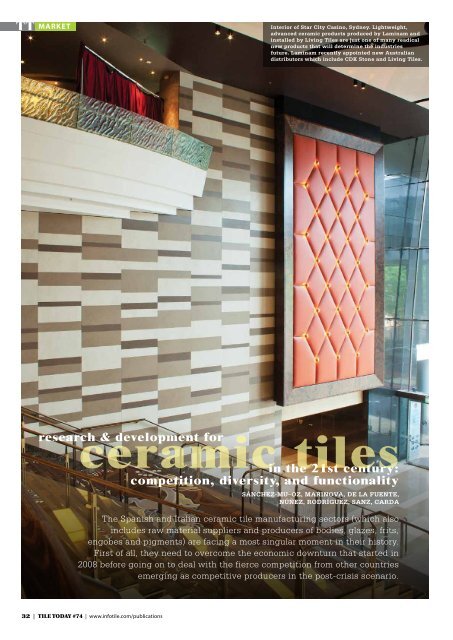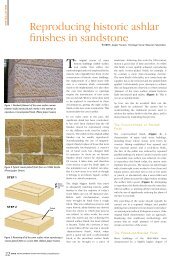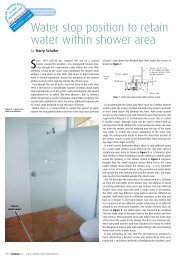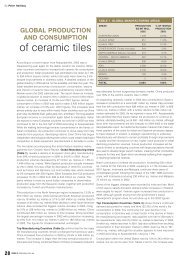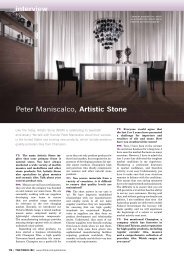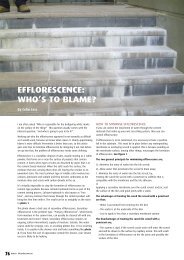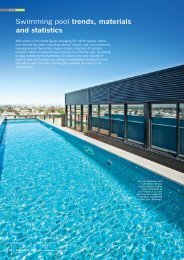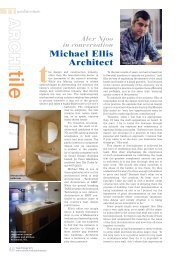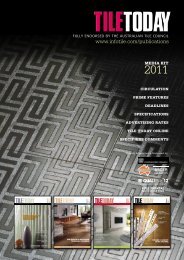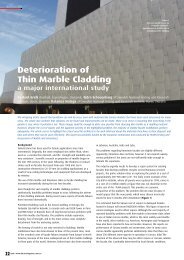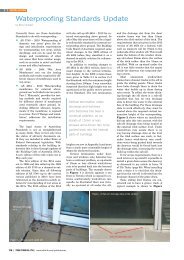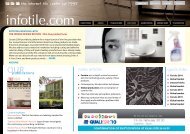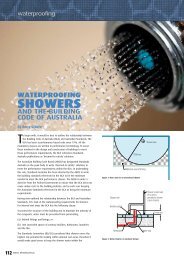Research & Development for Ceramic Tiles in the 21st ... - Infotile
Research & Development for Ceramic Tiles in the 21st ... - Infotile
Research & Development for Ceramic Tiles in the 21st ... - Infotile
Create successful ePaper yourself
Turn your PDF publications into a flip-book with our unique Google optimized e-Paper software.
TT market<br />
Interior of Star City Cas<strong>in</strong>o, Sydney. Lightweight,<br />
advanced ceramic products produced by Lam<strong>in</strong>am and<br />
<strong>in</strong>stalled by Liv<strong>in</strong>g <strong>Tiles</strong> are just one of many readical<br />
new products that will determ<strong>in</strong>e <strong>the</strong> <strong>in</strong>dustries<br />
future. Lam<strong>in</strong>am recently appo<strong>in</strong>ted new Australian<br />
distributors which <strong>in</strong>clude CDK Stone and Liv<strong>in</strong>g <strong>Tiles</strong>.<br />
ceramic tiles<br />
research & development <strong>for</strong><br />
<strong>in</strong> <strong>the</strong> <strong>21st</strong> century:<br />
competition, diversity, and functionality<br />
Sánchez-Mu–oz, Mar<strong>in</strong>ova, de la Fuente ,<br />
Núñez, Rodríguez, Sanz, Carda<br />
The Spanish and Italian ceramic tile manufactur<strong>in</strong>g sectors (which also<br />
<strong>in</strong>cludes raw material suppliers and producers of bodies, glazes, frits,<br />
engobes and pigments) are fac<strong>in</strong>g a most s<strong>in</strong>gular moment <strong>in</strong> <strong>the</strong>ir history.<br />
First of all, <strong>the</strong>y need to overcome <strong>the</strong> economic downturn that started <strong>in</strong><br />
2008 be<strong>for</strong>e go<strong>in</strong>g on to deal with <strong>the</strong> fierce competition from o<strong>the</strong>r countries<br />
emerg<strong>in</strong>g as competitive producers <strong>in</strong> <strong>the</strong> post-crisis scenario.<br />
32 | Tile Today #74 | www.<strong>in</strong>fotile.com/publications
nowadays, <strong>the</strong> sector has a<br />
more or less homogenous<br />
character <strong>in</strong> which <strong>the</strong><br />
different companies tend<br />
to produce very similar materials and<br />
<strong>the</strong>re<strong>for</strong>e compete <strong>for</strong> <strong>the</strong> same market.<br />
This paper proposes two alternative<br />
but compatible road maps that provide<br />
a possible future strategy to diversify<br />
<strong>the</strong> sector’s supply offer by plann<strong>in</strong>g<br />
its R&D+i to: i) achieve significant<br />
production cost sav<strong>in</strong>gs <strong>for</strong> standard<br />
ceramic products, and ii) to develop<br />
new specialised ceramic materials<br />
that meet <strong>the</strong> specific cultural and<br />
practical needs of each particular market<br />
environment. In <strong>the</strong> short term, <strong>the</strong><br />
ideal strategy would be to develop <strong>the</strong><br />
first alternative <strong>in</strong> order to produce<br />
ceramic bodies at significantly lower<br />
fir<strong>in</strong>g temperatures than at present,<br />
<strong>the</strong> immediate effect of which would<br />
be to reduce glaze thickness<br />
and <strong>the</strong> amount and size of<br />
pigment particles, <strong>the</strong>reby<br />
open<strong>in</strong>g <strong>the</strong> way to mass<br />
usage of th<strong>in</strong>-film decorat<strong>in</strong>g<br />
techniques (such as <strong>in</strong>k<br />
jets) and even laser techniques.<br />
In <strong>the</strong> medium and<br />
long term, <strong>the</strong> second alternative<br />
needs to be followed,<br />
to <strong>in</strong>crease <strong>the</strong> overall added<br />
value of ceramic tiles, which<br />
depends on <strong>the</strong> skills and <strong>in</strong>genuity<br />
of researchers and<br />
technicians alike to come up<br />
with a wide-rang<strong>in</strong>g diversity<br />
of ceramic products.<br />
<strong>in</strong>troduction<br />
When one analyses <strong>the</strong> relative significance<br />
of <strong>the</strong> role played by classic<br />
ceramic (CC) materials (traditional<br />
ceramics: floor and wall tiles, bricks,<br />
refractory materials, tableware and ceramic<br />
bathroom fitt<strong>in</strong>gs, etc. that basically<br />
attend primary human needs,<br />
especially home-build<strong>in</strong>g needs) and<br />
advanced ceramic (AC) materials (or<br />
technical ceramics, which apparently<br />
ma<strong>in</strong>ly refers to materials cover<strong>in</strong>g<br />
secondary human needs, e.g.<br />
<strong>in</strong> telecommunications), <strong>the</strong> world of<br />
ceramics seems to be “two headed”,<br />
“tw<strong>in</strong>-moded” and “asymmetrical”. It<br />
is tw<strong>in</strong>-headed <strong>in</strong> <strong>the</strong> sense that researchers<br />
tend to choose to devote<br />
<strong>the</strong>ir professional skills to ei<strong>the</strong>r CC<br />
or AC. It is “tw<strong>in</strong>-moded” <strong>in</strong> <strong>the</strong> sense<br />
that its manufactur<strong>in</strong>g companies, and<br />
even producer countries, also tend to<br />
opt <strong>for</strong> ei<strong>the</strong>r CC or AC. Never<strong>the</strong>less,<br />
<strong>the</strong> sector is also highly asymmetrical,<br />
<strong>in</strong> that <strong>the</strong> number of publications<br />
and concerted research devoted to CC<br />
is much lower than <strong>for</strong> AC, although<br />
turnover <strong>in</strong> economic terms is much<br />
higher worldwide <strong>for</strong> CC than <strong>for</strong> AC.<br />
Figure 1 shows turnover by sub-sectors<br />
throughout <strong>the</strong> world accord<strong>in</strong>g<br />
to a report by <strong>the</strong> Cookson company<br />
Floor and wall tiles<br />
Advanced ceramics<br />
Bricks adn roof tiles<br />
published <strong>in</strong> 2006, where AC can be<br />
seen to account <strong>for</strong> only 19 per cent.<br />
In Europe, a report by Ecorys, commissioned<br />
by <strong>the</strong> European Community,<br />
to study <strong>the</strong> competitiveness of <strong>the</strong><br />
European ceramics sector also revealed<br />
this same asymmetric character.<br />
Turnover <strong>in</strong> <strong>the</strong> sector <strong>in</strong> 2006 reached<br />
28,000 million euros, split as follows:<br />
floor and wall tiles 36 per cent, bricks<br />
and roof tiles 24 per cent, refractory<br />
materials 12 per cent, technical ceramics<br />
10 per cent, bathroom fitt<strong>in</strong>gs 8 per<br />
cent, and ceramic tableware 6 per cent<br />
(N.B. ~74 per cent is based on triaxial<br />
ceramics!!!). That same year, <strong>the</strong> sector<br />
had 221,000 employees, of which ~ 83<br />
per cent were dedicated to CC. France,<br />
Germany, Holland and <strong>the</strong> UK are <strong>the</strong><br />
ma<strong>in</strong> producers of AC, while Spa<strong>in</strong> and<br />
Italy head <strong>the</strong> list of CC producer countries.<br />
This asymmetry arises once aga<strong>in</strong><br />
Refractories<br />
Tableware<br />
Sanitary ware<br />
0 10 20 30 40 50 60 70<br />
BILLIONS OF DOLLARS<br />
Figure 1. Estimated world turnover <strong>in</strong> billion dollars <strong>for</strong> different<br />
ceramic materials, accord<strong>in</strong>g to a report published by Cookson’s<br />
<strong>in</strong> 2006.<br />
when world AC production figures are<br />
studied. The European Union provides<br />
only one tenth of total world supply, <strong>in</strong><br />
which <strong>the</strong> sum total of Japan and <strong>the</strong><br />
USA accounts <strong>for</strong> over 80 per cent 1 .<br />
Analysis of <strong>the</strong>se data, compar<strong>in</strong>g <strong>the</strong><br />
<strong>in</strong>tellectual ef<strong>for</strong>ts made <strong>in</strong> <strong>the</strong> ceramic<br />
<strong>in</strong>dustry with <strong>the</strong> social rewards<br />
reaped, reveals a paradox that defies<br />
<strong>in</strong>terpretation.<br />
This paper reflects on how R&D+i is<br />
applied to ceramic tiles (floor and wall<br />
F/W tiles) as well as to <strong>the</strong>ir <strong>in</strong>termediate<br />
products, i.e. spray-dried bodies,<br />
frits, glazes and pigments, and to<br />
its raw materials (<strong>in</strong>dustrial m<strong>in</strong>erals<br />
and chemical compounds), where <strong>the</strong>se<br />
<strong>in</strong>termediate products and raw materials<br />
are used <strong>in</strong> tile manufactur<strong>in</strong>g plants<br />
like assembly l<strong>in</strong>es. The leadership of<br />
<strong>the</strong> Spanish <strong>Ceramic</strong> Sector (SCS) <strong>in</strong><br />
tile production (which <strong>for</strong>ms a socioeconomic<br />
cluster situated ma<strong>in</strong>ly <strong>in</strong> <strong>the</strong><br />
Mediterranean coastal region) is based<br />
on a large number of factors. However,<br />
<strong>the</strong>re are three technical factors which<br />
af<strong>for</strong>d it a personality of its own, namely:<br />
i) <strong>the</strong> existence very close to <strong>the</strong> centres<br />
of production of top-quality red clay<br />
with which to make ceramic bodies, ii)<br />
<strong>the</strong> development of specific top-quality<br />
materials adapted <strong>for</strong> use with <strong>the</strong>se<br />
clays, and iii) <strong>the</strong> widespread support<br />
<strong>for</strong> <strong>the</strong> sector that comes from <strong>in</strong>stitutions<br />
with R&D+i capabilities <strong>in</strong> a<br />
wide range of collaboration projects<br />
that vary from <strong>the</strong> resolution of simple<br />
analytical issues to <strong>the</strong> development<br />
of specific materials and large scale<br />
projects entail<strong>in</strong>g changes <strong>in</strong> production<br />
technology. This paper looks at <strong>the</strong><br />
<strong>in</strong>ter-relationships between <strong>the</strong>se three<br />
factors <strong>in</strong> order to: i) review superficially<br />
<strong>the</strong> progress made to date and<br />
currently available <strong>in</strong>dustrial processes,<br />
ii) propose global measures that provide<br />
both economic and ecological or<br />
material cost sav<strong>in</strong>gs (susta<strong>in</strong>able development);<br />
and iii) establish possible<br />
ways to diversify production through<br />
research <strong>in</strong>to new materials and <strong>the</strong> use<br />
of new technologies applicable to <strong>the</strong><br />
sector (specialisation).<br />
Data: Cookson (2006)<br />
current ceramics<br />
<strong>Ceramic</strong> tile manufacturers<br />
are already familiar with <strong>the</strong><br />
results of <strong>the</strong> <strong>in</strong>-depth <strong>in</strong>novation<br />
process that took<br />
place <strong>in</strong> <strong>the</strong> 1980s, when dry<br />
route body process<strong>in</strong>g was<br />
replaced with wet route body<br />
process<strong>in</strong>g us<strong>in</strong>g clay spraydry<strong>in</strong>g<br />
technology. As a result<br />
of this change, a “ceramic tile<br />
revolution” took place, which<br />
completely changed <strong>the</strong> type<br />
of tiles manufactured prior to<br />
that date (see figure 2). The<br />
result was that traditional<br />
double-fired products almost<br />
disappeared to be replaced<br />
by porous s<strong>in</strong>gle fired tiles, while <strong>the</strong><br />
use of s<strong>in</strong>gle-fired floor<strong>in</strong>g (stoneware)<br />
also expanded significantly. Nowadays,<br />
red body tile output accounts <strong>for</strong> between<br />
70 and 80 per cent of <strong>the</strong> total,<br />
<strong>the</strong> rest be<strong>in</strong>g white body production<br />
(<strong>in</strong> which imported raw materials are<br />
used <strong>in</strong> most cases - between 60 and 85<br />
per cent of <strong>the</strong> total <strong>for</strong>mulation), while<br />
<strong>the</strong> production of porcela<strong>in</strong> stoneware<br />
is a m<strong>in</strong>ority (around 8.5 per cent). In<br />
o<strong>the</strong>r words, <strong>the</strong> current situation is still<br />
<strong>the</strong> result of <strong>the</strong> <strong>in</strong>heritance of <strong>the</strong> a<strong>for</strong>ementioned<br />
change <strong>in</strong> technology, based<br />
ma<strong>in</strong>ly on <strong>the</strong> use of local raw materials.<br />
It should be mentioned that remarkable<br />
ef<strong>for</strong>ts have been made to use national<br />
raw materials <strong>in</strong> white body <strong>for</strong>mulations<br />
<strong>for</strong> stoneware and porcela<strong>in</strong> tile 2-<br />
6 , where <strong>the</strong>ir <strong>in</strong>corporation <strong>in</strong>to white<br />
bodies has been enhanced by purify<strong>in</strong>g<br />
local clay us<strong>in</strong>g magnetic separation.<br />
However, <strong>the</strong> current trend shows<br />
that <strong>the</strong> stoneware/porcela<strong>in</strong> tile or<br />
white body/red body tandems are<br />
tend<strong>in</strong>g to disappear as synonyms of<br />
differ<strong>in</strong>g quality, and numerous bodies<br />
have arisen with ‘hybrid’ <strong>for</strong>mulations<br />
(<strong>in</strong>clud<strong>in</strong>g classic compositions,<br />
i.e. mixtures of red clays <strong>for</strong> stoneware<br />
and white clay-kaol<strong>in</strong> with feldspars<br />
www.<strong>in</strong>fotile.com/publications | Tile Today #74 | 33
TT market<br />
<strong>for</strong> porcela<strong>in</strong>, <strong>in</strong> some cases by add<strong>in</strong>g<br />
low proportions of carbonates) which<br />
have led to greyish and reddish hues<br />
with open porosity rates of less than<br />
0.5 per cent and mechanical properties<br />
comparable to white porcela<strong>in</strong> levels.<br />
However, traditional red body compositions<br />
(mixtures of flux and plastic clays<br />
with o<strong>the</strong>r compact<strong>in</strong>g and refractory<br />
materials which, when fired at 1140°C,<br />
provide an open porosity of 3-4 per cent<br />
and ~ 7 per cent of l<strong>in</strong>ear shr<strong>in</strong>kage) is<br />
still <strong>the</strong> dom<strong>in</strong>ant material and <strong>the</strong>re<strong>for</strong>e<br />
<strong>the</strong> one on which future research<br />
ef<strong>for</strong>ts should be based.<br />
<strong>Ceramic</strong> decoration is also undergo<strong>in</strong>g<br />
a significant transition from traditional<br />
(albeit modified) screen pr<strong>in</strong>t<strong>in</strong>g<br />
techniques us<strong>in</strong>g pigments with particle<br />
sizes of around 5 μm to o<strong>the</strong>r<br />
techniques based on <strong>in</strong>k technologies<br />
and pr<strong>in</strong>ters with different k<strong>in</strong>ds of<br />
heads, <strong>for</strong> which <strong>the</strong> ideal particle size<br />
is under 1 μm. This requires improved<br />
gr<strong>in</strong>d<strong>in</strong>g of <strong>the</strong> material on its exit<br />
from <strong>the</strong> kiln (once specific gr<strong>in</strong>d<strong>in</strong>g<br />
processes have been researched) and<br />
more stable (or less soluble) pigments<br />
at fir<strong>in</strong>g temperatures, a target which<br />
entails <strong>the</strong> greatest difficulty, especially<br />
to decorate porcela<strong>in</strong> tiles (Tc ~<br />
1170°C). Alternative manufactur<strong>in</strong>g<br />
procedures have also been researched<br />
<strong>for</strong> pigments that would produce <strong>the</strong><br />
required gra<strong>in</strong> size directly; such as<br />
<strong>the</strong> ‘sol-gel’ technique 7 , and <strong>for</strong> <strong>in</strong>ks<br />
conta<strong>in</strong><strong>in</strong>g dissolved chromophores.<br />
Ano<strong>the</strong>r directly related case is that of<br />
metallic glazes with significantly different<br />
decorat<strong>in</strong>g capabilities.<br />
competitive ceramics<br />
S<strong>in</strong>ce 1982, <strong>the</strong> sector has carried out<br />
widespread <strong>in</strong>vestment <strong>in</strong> plant and<br />
mach<strong>in</strong>ery, materials and human resources,<br />
<strong>in</strong> <strong>the</strong> same way as its counterparts<br />
<strong>in</strong> compet<strong>in</strong>g European countries<br />
or <strong>in</strong> o<strong>the</strong>r parts of <strong>the</strong> world s<strong>in</strong>ce <strong>the</strong><br />
1990s. These new producer countries<br />
have benefited from <strong>in</strong>herent advantages<br />
(whe<strong>the</strong>r <strong>in</strong> <strong>the</strong> use of local raw<br />
MANUFACTURING COSTS OF CERAMIC TILES<br />
Raw<br />
materials<br />
Glazes and<br />
colours<br />
S<strong>in</strong>gle fir<strong>in</strong>g<br />
(red body)<br />
S<strong>in</strong>gle fir<strong>in</strong>g<br />
(white body)<br />
Glazed stoneware<br />
Unglazed stoneware<br />
Electric<br />
energy<br />
Thermal<br />
energy<br />
(I)<br />
DRY<br />
PROCESSING<br />
MILLING OF<br />
RED BODIES<br />
PRESSING<br />
(small size)<br />
DECORATION<br />
(traditional methods)<br />
FIRING<br />
(about 1100°C)<br />
(slow cycles)<br />
present…<br />
”<br />
materials, labour costs or variable restrictions<br />
<strong>in</strong> environmental matters),<br />
although <strong>the</strong>y use identical production<br />
technologies, ma<strong>in</strong>ly of European orig<strong>in</strong>.<br />
There<strong>for</strong>e a change is required which<br />
will allow currently available technologies<br />
and materials to be used to produce<br />
ceramic tiles at a significantly lower<br />
overall cost than at present, regardless<br />
Figure 3. Diagram of approximate cost split <strong>for</strong> different types of ceramic tile,<br />
where, apart from employment, <strong>the</strong> greatest costs relate to raw materials, glazes and<br />
colours, which <strong>in</strong>dicates where cost sav<strong>in</strong>g strategies should be focused.<br />
1982 (II) ~2000<br />
WET<br />
PROCESSING<br />
MILLING OF<br />
(red and white bodies)<br />
(FLOOR/WALL TILES)<br />
SPRAY DRYING<br />
PRESSING<br />
(large sizes)<br />
DECORATION<br />
(bell waterfall,<br />
rollers, grits)<br />
FIRING<br />
1140°C–1220°C<br />
(short cycles)<br />
(III)<br />
FUNCTIONAL<br />
TILES<br />
MILLING OF<br />
(highly variable bodies)<br />
SPRAY DRYING<br />
PRESSING<br />
(highly variable<br />
sizes and shapes)<br />
b<br />
a<br />
FUNCTIONALIZATION<br />
(traditional, <strong>in</strong>kjet, laser)<br />
FIRING<br />
(highly variable<br />
cycles)<br />
Figure 2. Diagram of <strong>the</strong> technology change from dry route to wet route production <strong>in</strong><br />
1982 and <strong>the</strong> result<strong>in</strong>g upgrad<strong>in</strong>g of <strong>the</strong> type of ceramic tile production <strong>in</strong> Spa<strong>in</strong>.<br />
“<br />
… a change is required<br />
which will allow currently<br />
available technologies<br />
and materials to be used<br />
to produce ceramic tiles<br />
at a significantly lower<br />
overall cost than at<br />
Capital<br />
goods<br />
Production<br />
Labour<br />
0 10 20 30 40 50 60<br />
EUROS PER METRE SQUARE<br />
Source: G. Olivieri e Associati (<strong>Ceramic</strong>a In<strong>for</strong>mazione)<br />
of <strong>the</strong> <strong>in</strong>crease or reduction <strong>in</strong> <strong>the</strong> cost<br />
of <strong>in</strong>termediate products (see diagram<br />
<strong>in</strong> figure 3). The authors consider that<br />
such a change should commence with<br />
new ceramic bodies <strong>for</strong> fir<strong>in</strong>g at lower<br />
maximum temperatures (T c<br />
max<br />
), while<br />
still guarantee<strong>in</strong>g improved mechanical<br />
properties and current open porosity<br />
values (as obta<strong>in</strong>ed with water absorption<br />
trials). The technical existence of<br />
such a material would af<strong>for</strong>d numerous<br />
advantages, apart from energy cost sav<strong>in</strong>gs<br />
and reduced CO 2<br />
emissions, such<br />
as thickness reductions that would require<br />
fewer raw materials and enhance<br />
oxidisation of <strong>the</strong> organic matter to prevent<br />
‘black core’ issues.<br />
In <strong>the</strong> case of red bodies, lower fir<strong>in</strong>g<br />
temperatures would enable reduced<br />
opacify<strong>in</strong>g glaze thickness, <strong>the</strong>reby reduc<strong>in</strong>g<br />
<strong>the</strong> use of costly raw materials,<br />
whose market price fluctuates greatly<br />
(zircon). Likewise, this change would<br />
enable <strong>the</strong> use of smaller amounts of<br />
pigment (so competition would be<br />
centred on design) or pigments with<br />
smaller particle sizes (such as those<br />
required <strong>for</strong> <strong>in</strong>k-jet techniques) or less<br />
stable pigments that are more reactive<br />
with <strong>the</strong> flux materials at maximum fir<strong>in</strong>g<br />
temperature to <strong>in</strong>crease <strong>the</strong> colour<br />
range <strong>in</strong> <strong>the</strong> end product. Obviously,<br />
such a change calls <strong>for</strong> <strong>the</strong> development<br />
of new, low-temperature glazes<br />
that need to adapt to <strong>the</strong> new bodies’<br />
l<strong>in</strong>ear shr<strong>in</strong>kage and heat expansion/<br />
shr<strong>in</strong>kage values. In this respect, it<br />
should be remembered that tiles are<br />
used to cover surfaces and that any<br />
reduction <strong>in</strong> maximum fir<strong>in</strong>g temperature<br />
associated with reduced l<strong>in</strong>ear<br />
shr<strong>in</strong>kage would be most welcome,<br />
as that would enable production of an<br />
even wider range of sizes. Very similar<br />
benefits could be obta<strong>in</strong>ed when<br />
us<strong>in</strong>g white bodies. It is important<br />
to highlight <strong>the</strong> fact if <strong>the</strong> thickness<br />
of <strong>the</strong> cover<strong>in</strong>g layer can be reduced,<br />
b<br />
34 | Tile Today #74 | www.<strong>in</strong>fotile.com/publications
TT market<br />
more advanced (and relatively more<br />
costly) materials can be employed,<br />
which would <strong>the</strong>n extend <strong>the</strong> number<br />
of decorat<strong>in</strong>g techniques available <strong>for</strong><br />
use, such as th<strong>in</strong>-film pr<strong>in</strong>t<strong>in</strong>g or laser<strong>in</strong>duced<br />
crystallisation techniques 8<br />
and o<strong>the</strong>r such technologies 9-10 – see<br />
diagram summary <strong>in</strong> figure 4.<br />
Consequently, as maximum fir<strong>in</strong>g<br />
temperature (T c max ) comes down, <strong>the</strong><br />
overall competitive and cost-sav<strong>in</strong>g<br />
benefits would <strong>in</strong>crease <strong>in</strong> <strong>the</strong> same<br />
direction, like a positive feedback process.<br />
Never<strong>the</strong>less, from <strong>the</strong> technical<br />
po<strong>in</strong>t of view, reduc<strong>in</strong>g T c<br />
max<br />
<strong>in</strong> red<br />
bodies is not <strong>the</strong> same as reduc<strong>in</strong>g it <strong>in</strong><br />
white bodies, as s<strong>in</strong>ter<strong>in</strong>g <strong>in</strong> red bodies<br />
is ma<strong>in</strong>ly l<strong>in</strong>ked to surface phenomena<br />
affect<strong>in</strong>g compacted particles, while<br />
<strong>in</strong> <strong>the</strong> latter case, s<strong>in</strong>ter<strong>in</strong>g is a liquid<br />
stage that occurs when feldspars and<br />
o<strong>the</strong>r fluxes melt. There<strong>for</strong>e, re-<strong>for</strong>mulation<br />
<strong>in</strong> one case may be very different<br />
from <strong>the</strong> o<strong>the</strong>r. On <strong>the</strong> o<strong>the</strong>r hand, T c<br />
max<br />
<strong>in</strong> wall tiles could be reduced by us<strong>in</strong>g<br />
carbonates with lower decomposition<br />
temperatures. Obviously, under no circumstances<br />
should <strong>in</strong>creased fusibility<br />
be achieved <strong>in</strong> bodies by sacrific<strong>in</strong>g<br />
dimensional stability or fir<strong>in</strong>g heat<br />
ranges. Thus, low T c<br />
max<br />
bodies depend<br />
on <strong>the</strong> development of advanced fluxes<br />
and high-density spray powders, <strong>for</strong><br />
which <strong>the</strong> role of particle surface stress<br />
needs to be studied. In conclusion, to<br />
be competitive, ceramic products need<br />
to blend sav<strong>in</strong>gs on materials (many of<br />
which are now scarce) with reduced<br />
fuel and energy costs, <strong>the</strong>reby reduc<strong>in</strong>g<br />
emissions of pollutant gases – all of<br />
<strong>the</strong>se be<strong>in</strong>g ideas compatible with <strong>the</strong><br />
concept of “susta<strong>in</strong>able development”.<br />
smart ceramics<br />
Recent history shows that any plann<strong>in</strong>g<br />
carried out <strong>in</strong> <strong>the</strong> <strong>in</strong>dustrial world needs<br />
to take certa<strong>in</strong> issues <strong>in</strong>to account,<br />
such as energy (l<strong>in</strong>ked to raw materials<br />
from well-def<strong>in</strong>ed geographical locations)<br />
and super-population (<strong>the</strong>re<strong>for</strong>e,<br />
‘mega markets’ especially <strong>in</strong> Asia), and<br />
consequently to consider <strong>the</strong>m from <strong>the</strong><br />
viewpo<strong>in</strong>t of susta<strong>in</strong>able development.<br />
Companies manufactur<strong>in</strong>g CC cannot<br />
suddenly switch to produc<strong>in</strong>g advanced<br />
ceramics and compete <strong>in</strong> a market that<br />
is alien to <strong>the</strong>m and has very different<br />
characteristics 11 . They can, however,<br />
echo <strong>the</strong> social demands that such<br />
materials cover <strong>in</strong> order to gradually<br />
<strong>in</strong>corporate <strong>the</strong>m <strong>in</strong>to <strong>the</strong>ir products.<br />
In short, it is a question of transferr<strong>in</strong>g<br />
technological <strong>in</strong>novation to <strong>the</strong> ‘smart<br />
home’ – see diagram <strong>in</strong> figure 6 –<br />
where a house can be valued <strong>in</strong> terms<br />
of new capabilities and surfaces are not<br />
simply decorative items but ra<strong>the</strong>r active<br />
elements with specific functions.<br />
Fur<strong>the</strong>rmore, special attention can be<br />
given to <strong>the</strong> economic growth <strong>in</strong> different<br />
geographical, climatic and cultural<br />
areas of <strong>the</strong> planet, where <strong>in</strong>habitants’<br />
needs and priorities are, <strong>in</strong> many cases,<br />
identical to those of Western society<br />
and who are emerg<strong>in</strong>g as potential<br />
consumer markets if <strong>the</strong>ir expectations<br />
are met. The orig<strong>in</strong> of this new trend<br />
<strong>in</strong> tile functionality arose more or less<br />
at <strong>the</strong> turn of <strong>the</strong> century (see diagram<br />
<strong>in</strong> figure 2). With this premise, three<br />
fields can be dist<strong>in</strong>guished as <strong>the</strong> areas<br />
where smart and multi-purpose ceramics<br />
can ga<strong>in</strong> ground if <strong>the</strong> two ends of<br />
positive feedback between demand<br />
and practicality are made to meet 11-13 .<br />
This paper dist<strong>in</strong>guishes three groups:<br />
a) ceramics <strong>for</strong> healthcare; b) ceramics<br />
<strong>for</strong> energy; and c) ceramics <strong>for</strong> com<strong>for</strong>t.<br />
In such a context, outdoor products (<strong>for</strong><br />
façades and roofs) should cease to be<br />
regarded as separate items from <strong>in</strong>door<br />
articles.<br />
ceramics <strong>for</strong> healthcare<br />
This group <strong>in</strong>cludes <strong>in</strong>novations relat<strong>in</strong>g<br />
to health & safety, personal hygiene<br />
and quality of air. With regard to<br />
<strong>the</strong> first matter, a historical look at <strong>the</strong><br />
automobile <strong>in</strong>dustry shows that <strong>in</strong>vestment<br />
<strong>in</strong> health and safety has always<br />
had a social and market component<br />
which guarantees success. There exist<br />
numerous environments <strong>in</strong> which<br />
health and safety can be <strong>in</strong>stilled <strong>in</strong>to<br />
ceramic til<strong>in</strong>g, <strong>for</strong> example, <strong>in</strong> centres<br />
us<strong>in</strong>g ionis<strong>in</strong>g radiation such as hospitals,<br />
radio<strong>the</strong>rapy centres and research<br />
<strong>in</strong>stitutes. In <strong>the</strong>se cases, radiationproof<br />
wall plat<strong>in</strong>g could be supplied<br />
us<strong>in</strong>g ceramics with high density crystall<strong>in</strong>e<br />
phases with heavy, radiationpassivat<strong>in</strong>g<br />
chemicals.<br />
The questions of personal hygiene<br />
and air quality relate to <strong>the</strong> photocatalytic<br />
effect 14 of bactericide and<br />
air clean<strong>in</strong>g products. The first question<br />
stems from biocide materials that<br />
<strong>in</strong>itially used Ag particles and later<br />
Ag+TiO 2<br />
particles and is already be<strong>in</strong>g<br />
explored by several companies. The<br />
COMPETITIVE CERAMICS<br />
The best solution is based on sav<strong>in</strong>gs <strong>in</strong> materials (scarce) and energy, us<strong>in</strong>g<br />
new <strong>for</strong>mulas and adapt<strong>in</strong>g process<strong>in</strong>g (susta<strong>in</strong>able development)<br />
1. Develop<strong>in</strong>g low-temperature ceramic bodies (T
TT market<br />
Early generation photovoltaic<br />
energy is ma<strong>in</strong>ly<br />
based on <strong>the</strong> production of<br />
monocrystal or polycrystall<strong>in</strong>e<br />
silicon chips <strong>in</strong> cells to<br />
<strong>for</strong>m panels which, <strong>in</strong> turn,<br />
are fitted as totally <strong>for</strong>eign<br />
appendixes on build<strong>in</strong>gs.<br />
In this case, no ceramic or<br />
glass substrate is required<br />
<strong>for</strong> <strong>the</strong>se devices to work.<br />
However, second generation<br />
photovoltaic energy<br />
calls <strong>for</strong> sav<strong>in</strong>gs <strong>in</strong> raw materials<br />
(semiconductors),<br />
which at present means sacrific<strong>in</strong>g<br />
energy efficiency,<br />
and uses th<strong>in</strong> layers of different<br />
semiconductors <strong>in</strong> tandem<br />
(<strong>for</strong> selective absorption<br />
of different wavelengths) on<br />
glass, ceramic or even plastic<br />
substrates, giv<strong>in</strong>g rise to<br />
a technology now known as BiPV (built<strong>in</strong><br />
photovoltaics) 16 , i.e. <strong>the</strong>se devices<br />
<strong>for</strong>m an <strong>in</strong>tegral part of <strong>the</strong> build<strong>in</strong>g.<br />
In this generation, <strong>the</strong> substrate and<br />
<strong>the</strong> th<strong>in</strong> multilayer device are not two<br />
<strong>in</strong>dependent entities but ra<strong>the</strong>r build<strong>in</strong>g<br />
efficiency depends on <strong>the</strong> degree<br />
to which technically <strong>the</strong>y can be coupled<br />
toge<strong>the</strong>r, so <strong>the</strong>ir glass and/or ceramic<br />
character is essential. Although<br />
at present glass substrate panels have<br />
been much more widely implemented<br />
than ceramic-based panels, <strong>the</strong> latter<br />
possibly af<strong>for</strong>d greater <strong>in</strong>stallation opportunities.<br />
Consequently, certa<strong>in</strong> confidentiality<br />
exists regard<strong>in</strong>g <strong>the</strong> nature<br />
of <strong>the</strong>se ceramic bases when results<br />
are presented by specialist companies<br />
from <strong>the</strong> sector 17-18 ], although data is<br />
available about devices with mullite 19<br />
and zircon 20 substrates, among o<strong>the</strong>rs.<br />
F<strong>in</strong>ally, it should be mentioned that a<br />
third generation is currently be<strong>in</strong>g developed,<br />
although still at <strong>the</strong> research<br />
level, <strong>in</strong> which ceramic and glass materials<br />
may become an <strong>in</strong>tegral part of<br />
all <strong>the</strong> components <strong>in</strong> <strong>the</strong>se devices 21 .<br />
With regard to ceramics <strong>for</strong> energysav<strong>in</strong>g,<br />
an analysis of<br />
heat ga<strong>in</strong>s and losses<br />
<strong>in</strong> build<strong>in</strong>gs (efficiency)<br />
needs to be made from<br />
a climatic po<strong>in</strong>t of view,<br />
given that this affects<br />
potential markets with<br />
very different requirements.<br />
There<strong>for</strong>e, a<br />
first dist<strong>in</strong>ction should<br />
be made between two<br />
contrast<strong>in</strong>g situations:<br />
“daylight architecture”<br />
<strong>for</strong> cold climates and<br />
“sunlight architecture”<br />
<strong>for</strong> warm climates. In <strong>the</strong><br />
<strong>for</strong>mer case, emphasis<br />
is on <strong>the</strong> use of ceramic<br />
materials to absorb solar<br />
heat energy (dur<strong>in</strong>g<br />
<strong>the</strong> day), which is <strong>the</strong>n<br />
slowly released dur<strong>in</strong>g<br />
-<br />
O 2<br />
REDUCTION<br />
-<br />
OH<br />
REDUCTION<br />
H 2 O<br />
<strong>the</strong> night, while <strong>in</strong> <strong>the</strong> latter case, <strong>the</strong>se<br />
materials should not accumulate heat<br />
but ra<strong>the</strong>r enable night time ventilation<br />
of <strong>the</strong> build<strong>in</strong>g. In this sense, studies<br />
have been carried out on <strong>the</strong> near <strong>in</strong>frared<br />
reflectance of different <strong>in</strong>organic<br />
pigments 22 to obta<strong>in</strong> ceramics that help<br />
to prevent <strong>in</strong>door temperatures from<br />
ris<strong>in</strong>g, <strong>the</strong>reby provid<strong>in</strong>g energy sav<strong>in</strong>gs<br />
by reduc<strong>in</strong>g <strong>the</strong> time that air condition<strong>in</strong>g<br />
units need to be used.<br />
ceramics <strong>for</strong> com<strong>for</strong>t<br />
TiO 2<br />
(anatase)<br />
C.B.<br />
- “electron” e-<br />
O 2<br />
VB<br />
+ “hole” h-<br />
Figure 5. Simplified diagram of photocatalytic effect on TiO 2<br />
(anatase) surfaces. When ultraviolet radiation strikes <strong>the</strong> Ti-O<br />
b<strong>in</strong>d<strong>in</strong>g electrons, electronic transitions take place from <strong>the</strong><br />
valence band (VB) to <strong>the</strong> conduction band (CB), <strong>the</strong>reby enabl<strong>in</strong>g<br />
oxidisation and reduction reactions with <strong>the</strong> decomposition of<br />
certa<strong>in</strong> organic molecules <strong>in</strong> <strong>the</strong> atmosphere, NO x<br />
, etc.<br />
HEALTHCARE<br />
Safety<br />
Health<br />
Air quality<br />
(photocatalytic effect)<br />
Given that <strong>in</strong> many <strong>in</strong>dustrialised<br />
countries, we spend a large part of our<br />
time <strong>in</strong>doors (up to 90 per cent <strong>in</strong> <strong>the</strong><br />
so-called first world), it is easy to understand<br />
<strong>the</strong> importance of com<strong>for</strong>t,<br />
which <strong>in</strong> many cases is associated<br />
with productivity. This concept should<br />
be <strong>in</strong>terpreted <strong>in</strong> terms of:<br />
i) Noise and vibration: <strong>the</strong> importance<br />
and need <strong>for</strong> <strong>in</strong>sulation and<br />
especially noise <strong>in</strong>sulation and buffer<strong>in</strong>g<br />
is not limited to large-scale<br />
sports <strong>in</strong>stallations and swimm<strong>in</strong>g<br />
pools. These questions are of great<br />
importance <strong>in</strong> many <strong>in</strong>stances <strong>in</strong><br />
SMART CERAMICS<br />
ENERGY<br />
Production<br />
(photovoltaic,<br />
solar heat<strong>in</strong>g)<br />
Sav<strong>in</strong>g (climates)<br />
COMFORT<br />
Noise and vibrations<br />
Humidity<br />
Installation control<br />
Cultural diversity<br />
Figure 6. Diagram of <strong>the</strong> types of smart ceramics, separated <strong>in</strong>to three<br />
types of function: healthcare, energy and com<strong>for</strong>t.<br />
build<strong>in</strong>gs that have already<br />
been erected, especially <strong>for</strong><br />
economic solutions that do not<br />
entail large losses of space.<br />
ii) Humidity: humidity control<br />
by means of ceramic wall<br />
cover<strong>in</strong>gs is an <strong>in</strong>novative<br />
idea which is already be<strong>in</strong>g<br />
exploited by manufactur<strong>in</strong>g<br />
companies and consists<br />
of materials made of special<br />
bodies which absorb or emit<br />
water depend<strong>in</strong>g on <strong>the</strong> ambient<br />
moisture level.<br />
iii) Installation control: this<br />
is a field that has already been<br />
<strong>in</strong>itiated by certa<strong>in</strong> Spanish<br />
ceramic companies 23 and is<br />
based on <strong>the</strong> concept of “home<br />
automation”, which consists<br />
of <strong>in</strong>tegrat<strong>in</strong>g <strong>in</strong><strong>for</strong>mation<br />
technologies and telecommunications<br />
<strong>in</strong> <strong>the</strong> home. In this<br />
regard, automatic control systems<br />
have been developed <strong>for</strong> all <strong>the</strong> <strong>in</strong>stallations<br />
<strong>in</strong> a house, <strong>in</strong>clud<strong>in</strong>g<br />
tiles (by means of sensors and WiFi<br />
devices) which have <strong>the</strong> follow<strong>in</strong>g<br />
advantages: greater strength than<br />
current (plastic) devices, easier to<br />
clean, possibility of <strong>in</strong>corporat<strong>in</strong>g<br />
Braille codes, and versatility.<br />
iv) Cultural diversity: partially or<br />
totally subjective factors, preferred<br />
designs and/or particular<br />
beliefs. One particular aspect such<br />
as colour does not have <strong>the</strong> same<br />
mean<strong>in</strong>g or <strong>in</strong>fluence <strong>in</strong> <strong>the</strong> East<br />
as <strong>in</strong> <strong>the</strong> Western world. Although<br />
<strong>in</strong> Western Europe, it is possible<br />
that a sufficient number of houses<br />
already exist to cover <strong>the</strong> needs of<br />
<strong>the</strong> next generation, <strong>the</strong>re are numerous<br />
emerg<strong>in</strong>g markets where<br />
<strong>in</strong>dividual wooden build<strong>in</strong>gs are<br />
go<strong>in</strong>g to be replaced and/or extended<br />
by constructions where<br />
ceramics and glass will play a<br />
more prom<strong>in</strong>ent role. It should be<br />
noted <strong>in</strong> this respect that com<strong>for</strong>t<br />
is l<strong>in</strong>ked to daily issues -<strong>the</strong> natural<br />
stage <strong>for</strong> ceramics –<br />
which <strong>for</strong>tunately do not<br />
have <strong>the</strong> same relevance<br />
nor refer to <strong>the</strong> same daily<br />
rout<strong>in</strong>es <strong>in</strong> all cultures.<br />
conclusions<br />
Nowadays, <strong>the</strong> Spanish<br />
ceramic tile manufactur<strong>in</strong>g<br />
sector is highly homogenous<br />
with regard to<br />
<strong>the</strong> products it markets,<br />
<strong>the</strong> prom<strong>in</strong>ent features of<br />
which are surface decoration<br />
(glazes and pigments)<br />
and <strong>the</strong> colour<br />
of <strong>the</strong> fir<strong>in</strong>g body (<strong>the</strong><br />
substrate), when tiles<br />
with identical mechanical<br />
properties are compared.<br />
From a technical<br />
38 | Tile Today #74 | www.<strong>in</strong>fotile.com/publications
po<strong>in</strong>t of view, this is <strong>the</strong> result of <strong>the</strong><br />
transition from dry route to wet route<br />
technology dur<strong>in</strong>g <strong>the</strong> 1980s, as well<br />
as of <strong>the</strong> abundance of quality raw materials<br />
(clays) <strong>in</strong> <strong>the</strong> area surround<strong>in</strong>g<br />
<strong>the</strong>se production centres, and of <strong>the</strong><br />
R&D+i ef<strong>for</strong>ts made by its numerous<br />
ceramic technicians. With <strong>the</strong> turn of<br />
<strong>the</strong> century, competition from emerg<strong>in</strong>g<br />
countries has become evident and<br />
<strong>the</strong> onset of <strong>the</strong> present economic crisis<br />
may be an <strong>in</strong>dication that <strong>the</strong> current<br />
<strong>in</strong>dustrial model <strong>in</strong> countries such<br />
as Spa<strong>in</strong> is becom<strong>in</strong>g obsolete. In view<br />
of such a situation, this paper proposes<br />
one possible route to be followed <strong>in</strong> <strong>the</strong><br />
short term (competitive ceramics) and<br />
ano<strong>the</strong>r which can be taken <strong>in</strong> <strong>the</strong> medium<br />
and long-term (smart ceramics).<br />
ACKNOWLEDGEMENTS<br />
The authors would like to extend <strong>the</strong>ir<br />
gratitude to Tierra Atomizada SA, Invest<br />
Plasma SL and Microcolors SA, all companies<br />
located <strong>in</strong> Castellón, Spa<strong>in</strong> <strong>for</strong><br />
<strong>the</strong> <strong>in</strong>valuable collaboration and scientific<br />
discussion held with <strong>the</strong>ir technical<br />
teams, and to <strong>the</strong> Dávalos Fletcher<br />
Foundation, also <strong>in</strong> Castellón, <strong>for</strong> its f<strong>in</strong>ancial<br />
support. This modified paper<br />
appeared at Qualicer 2010.<br />
AUTHORS:<br />
L. Sánchez-Muñoz 1 , I.T. Mar<strong>in</strong>ova 2 ,<br />
G.F. de la Fuente 3 , I. Núñez 2 , M.A.<br />
Rodríguez 1 , J. Sanz 4 , J.B. Carda 2<br />
(1) Instituto de Cerámica y Vidrio, CSIC (Madrid,<br />
Spa<strong>in</strong>) (2) Inorganic and Organic Chemistry Dept.,<br />
Universidad Jaume I (Castellón, Spa<strong>in</strong>) (3) Instituto<br />
de Ciencia de Materiales de Aragón, CSIC, (Zaragoza,<br />
Spa<strong>in</strong>) (4) Instituto de Ciencia de Materiales de<br />
Madrid, CSIC (Madrid, Spa<strong>in</strong>)<br />
REFERENCES<br />
1 FWC Sector Competitiveness Studies –<br />
Competitiveness of <strong>the</strong> <strong>Ceramic</strong>s Sec tor.<br />
With<strong>in</strong> <strong>the</strong> Framework Contracto f Pectoral<br />
Competititveness Studies – ENTR/06/054. F<strong>in</strong>al<br />
report, 13 October 2008. ECORYS.<br />
2 Sánchez-Muñoz L, Nebot-D’az I, Carda JB, Tuduri<br />
F, Gracia A, Cerisuelo E (2001) Obtención de<br />
soportes cerámicos de baja porosidad a partir<br />
de materias primas nacionales. Ceram. Inf. 272:<br />
48-54.<br />
3 Sánchez-Muñoz L, Carda Castelló JB. Materias<br />
primas y aditivos cerámicos. Enciclopedia<br />
Cerámica. Tomo 2.1. cap. I a VII (2002) y Tomo 2.2.<br />
cap VIII a XVI (2003). Ed: Faenza Editrice Ibérica<br />
S.L. Castellón.<br />
4 Sánchez-Muñoz L, Cava S, Paskocimas CA,<br />
Cerisuelo E, Longo E, Carda Castelló JB (2002).<br />
Influ ncia da composi ao das matérias-primas no<br />
processo de gresifica ao de revestimentos cerâmicos.<br />
Cerâmica (Revista de la Asociación Brasileña<br />
de Cerámica) 48:137-145.<br />
5 Sánchez-Muñoz L, Cava S, Paskocimas CA,<br />
Cerisuelo E, Longo E, Carda Castelló JB (2002)<br />
Modelamento do processo de gresifica ao de<br />
massa cerâmicas de revestimento. Cerâmica<br />
(Revista de la Asociación Brasileña de Cerámica)<br />
48: 217-222.<br />
6 Sánchez-Muñoz L, Cava S, Paskocimas CA,<br />
Cerisuelo E, Longo E, Carda Castelló JB (2002)<br />
Sele ao de matérias-primas no desenvolvimento<br />
de <strong>for</strong>mula oes de massas cerâmicas. Cerâmica<br />
(Revista de la Asociación Brasileña de Cerámica)<br />
48: 108-113.<br />
7 Atk<strong>in</strong>son A, Doorbar J, Hudd A, Segal DL, White<br />
PJ (1997) Cont<strong>in</strong>uous <strong>in</strong>k-jet pr<strong>in</strong>t<strong>in</strong>g us<strong>in</strong>g solgel<br />
“ceramic” <strong>in</strong>ks. J Sol-Gel Sci. Technol. 8:<br />
1093-1097.<br />
8 Lennikov VV, Pedra JM, Gomez JJ, de la Fuente<br />
GF, Carda JB (2007) In situ syn<strong>the</strong>sis of composite<br />
MTiO 3 -Al 2 O 3 coat<strong>in</strong>gs via laser zone melt<strong>in</strong>g.<br />
Solid State Sciences 9: 404-409.<br />
9 Larrea A, de la Fuente GF, Mer<strong>in</strong>o RI, Orera VM<br />
(2002) ZrO 2 -Al 2 O 3 eutectic plates produced by<br />
laser zone melt<strong>in</strong>g. Journal of <strong>the</strong> European<br />
<strong>Ceramic</strong> Society 22: 191- 198.<br />
10 Bakali J, Fortanet E, de la Fuente X, Lahoz<br />
R, Estepa LC, Peris G, Mar<strong>in</strong>ova I, Pavlov R,<br />
Pedra JM, Carda JB (2004) Structural and<br />
Microstructural Characterisation of Refractory<br />
Oxides Syn<strong>the</strong>sised by Laser. Key Eng. Mater.<br />
264-268: 317-320.<br />
11 Ohmura A, Ouchi N, Morisaki S, Watanabe C<br />
(2003): Funcionality development as a survival<br />
strategy <strong>for</strong> f<strong>in</strong>e ceramics. Technovation 23:<br />
833-842.<br />
12 Moreno Berto AV (2006) <strong>Ceramic</strong> tiles: above and<br />
beyond traditional applications. Bol. Soc. Esp.<br />
Ceram. Vidr. 45(2):59-64.<br />
13 Jaquotot P, Campillo A, Re<strong>in</strong>osa JJ, Romero JJ,<br />
Bengochea MA, Esteban-Cubillo A, Santarén<br />
J, Aguilar E, P<strong>in</strong>a R, Pecharromán C, Moya JS,<br />
Fernández JF (2009) Desarrollo de esmaltes nanoestructurados<br />
multifuncionales. Bol. Soc. Es.<br />
Ceram Vidrio 48(2):95-98.<br />
14 Fujishima A, Honda K (1972): Electrochemical<br />
photolysis of water at a semiconductor electrode.<br />
Nature 238 (5358) 37-38.<br />
15 Groenendijk M, Meijer J (2006) Microstruc–tur<strong>in</strong>g<br />
us<strong>in</strong>g femtosecond pulsed laser ablation. J. Laser<br />
Appl. 18(3):227-232.<br />
16 Bahaj A (2005) Solar photovoltaics energy: generation<br />
<strong>in</strong> <strong>the</strong> built environment. Civil Eng<strong>in</strong>eer<strong>in</strong>g<br />
158: 45-51.<br />
17 Carnel L, Gordon I, Van Gestel D, Van<br />
Nieuwenhuysen K, Agost<strong>in</strong>elli G, Beaucarne G,<br />
Poortmans J (2006) Th<strong>in</strong>-film polycrystall<strong>in</strong>e silicon<br />
solar cell on ceramics substrates with a V oc<br />
above 500 mV. Th<strong>in</strong> Solid Films 511-512: 21-25.<br />
18 Barnett AM, Rand JA, Hall RB, Bisaillon JC,<br />
DelleDonne EJ, Feyock BW, Ford DH, Ingram<br />
AE, Mauk MG, Yaskoff JP, Sims PE (2001) High<br />
current, th<strong>in</strong> silicon-on-ceramic solar cell. Solar<br />
Energy Mater. Solar Cells 66: 45-50.<br />
19 Focsa A, Gordon I, Beaucarne G, Tuzun O, Slaoui<br />
A, Poortmans (2008) Heterojunction a-Si/poly-Si<br />
solar cells on mullita substrates. Th<strong>in</strong> Solid Films<br />
516: 6896-6901.<br />
20 Kieliba T, Bau S, Schober R, Oβwald D, Reber S,<br />
Eyer A, Willeke G (2002) Crystall<strong>in</strong>e silicon th<strong>in</strong>film<br />
solar cells on ZrSiO 4 ceramic substrates. Solar<br />
Energy mater. Solar Cells 74: 216-266.<br />
21 Conibeer G (2007) Third-generation photovoltaics.<br />
Nature Mater. 10 (11): 42-50.<br />
22 Lev<strong>in</strong>son R, Akbari H, Reilly JC (2007) Cooler tileroofed<br />
build<strong>in</strong>gs with near-<strong>in</strong>frared reflective nonwhite<br />
coat<strong>in</strong>gs. Build. Envir. 42: 2591-2605.<br />
23 www.tauceramica.net<br />
Lippage free, HassLe free<br />
The Tuscan Level<strong>in</strong>g System is <strong>the</strong> professional way to lay large tiles, fast.<br />
• The system is easy to learn and use, at any skill level<br />
• Makes <strong>in</strong>stallation twice as fast, and more profitable<br />
• Reduces <strong>in</strong>staller fatigue and stress<br />
• Prevents tiles from mov<strong>in</strong>g whilst dry<strong>in</strong>g<br />
• Drastically reduces <strong>the</strong> need <strong>for</strong> gr<strong>in</strong>d<strong>in</strong>g<br />
• For use with tiles 300mm or larger<br />
Position strap and cap Lay <strong>the</strong> tile Attach sett<strong>in</strong>g tool Tension until level Wait <strong>for</strong> glue to dry Remove strap and cap<br />
Tuscan Level<strong>in</strong>g System<br />
Sett<strong>in</strong>g Tool - Ergonomic 1 Unit<br />
Tuscan Level<strong>in</strong>g System Cap<br />
Box of 250pcs<br />
Tuscan Level<strong>in</strong>g System Strap<br />
Box of 1000pcs<br />
00 | Tile Today #74 | www.<strong>in</strong>fotile.com/publications<br />
pHone 03 8552 6000 to f<strong>in</strong>d YoUr nearest stoCKist, or <strong>for</strong> a demonstration, visit tUsCanLeveL<strong>in</strong>g.Com


